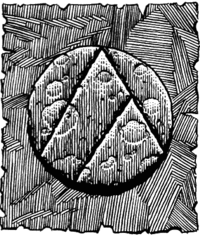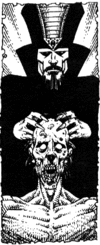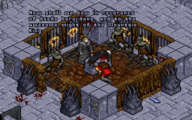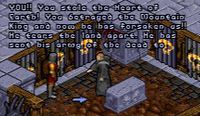Necromancer
This article is about the Necromancers of Pagan. For For other uses, see Necromancers (Disambiguation).
The Necromancers of Pagan are the servants of the Elemental Titan Lithos.
Description[edit]
The Necromancers are one of the four groups that wield titanic magic, their power of Necromancy being mainly concerned with earth and death. Living on the cemetery east of Tenebrae, the people avoid them as much as possible, as many ugly and mostly untrue rumors, such as they eat dead bodies, persist. The burying of the dead pacify Lithos, who uses the corpses for his ever growing army of the dead. In return for these services, Lithos leaves Pagan in peace; spared from his earthquakes and undead.
The order recognizes three ranks. At the top stands the Necromancer. He or she is responsible for the most important tasks, which if done wrong could enrage Lithos. The favored student of the Necromancer – who is groomed to become the next Necromancer – is called the Scion. The other members of the order do not hold any specific title. Succession of Necromancers only happens upon death, where the First Scion had to perform the Ritual of Eternity with the ritual dagger to send the dying Necromancer to Lithos.
History[edit]
The order of the Necromancers came into being when a man named Moriens made a bargain with Lithos in that the Titan would receive the dead of the land, and in turn he would no longer torment the people with earthquakes and undead attacks. Since the secret of immortality was not in Lithos' powers, he allowed the mortal Moriens to found the order of the Necromancers, while the dead Necromancers would serve even after their demise. Even though this act did grant them the leadership of Tenebrae, the unpleasant work with corpses started to alienate them from the population. So after the Tempests trapped Hydros and gained power, the Necromancers gladly turned rulership over to them and move to the cemetery, which only helped to isolate them further from the general population of Pagan.
When the Avatar arrived in Pagan in Ultima VIII, the Necromancers were in a crisis due to their isolation from the populace. Only two members of the order were left, the elder Necromancer Lothian dying of old age. The Avatar took the place of the Scion of the last Necromancer, Vividos, and went through all rituals. However, in the end the Avatar took away the power of Necromancy from the Necromancers when retrieving the Heart of Earth from the Conventicle of the Dead. With the following destruction of Lithos, the order lost its purpose.
Lore[edit]
| “ | The elder Pagans knew it would be impossible to overcome the might of the Titans, so they sought to bargain instead. They sent a champion, Moriens, to the Hall of the Mountain King to plead with Lithos, begging him to cease his destructive quakes. In return, Lithos demanded the service of the people, even beyond life. Upon their deaths the people were to be interred, and thus conveyed to his realm for eternal slavery. In addition, ordered the hungry Mountain King, several Pagans must be given to him immediately. With this pact Lithos would not only quiet the land, but also instill within Moriens the magical powers necessary to perform rituals required to satisfy the Titan of Earth, including minor manipulation of the earth. The elders accepted the terrible price and the covenant was formed. Moriens became the leader of the Pagans — the first in a long line of Necromancers. He established a cemetery near the newly built Tenebrae, City of eternal Twilight. He selected several elderly citizens to volunteer as Lithos’ first servants. As agreed, the tremors ended and the earth calmed. As the decades passed, Moriens began to feel within himself the infirmity of age and its resultant illnesses. He went to Lithos and asked to have his life extended so that he might continue his work. The Mountain King explained that such was not within his power, but that there was another way to have the Pagans continue their service. He permitted Moriens to choose an Apprentice so that, upon his death, a new Necromancer would assume his position. In turn, the deceased Necromancer would enter into a different service that the other Pagans, one that involved eternal rest, where his wisdom could be called upon by other Necromancers down through the ages. Each succeeding Necromancer would, in turn, find an Apprentice to whom the powers would be passed on upon death. The earth shook no more, but still the volcano raged, the winds blew and the rains fell. – from The Chronicle of Pagan (Ultima VIII)
|
|---|
Becoming a Necromancer[edit]
To become a Necromancer, the following rites have to be passed:
- The first test is as simple as retrieving two reagents. Finding these proves that they are serious, and they are then declared a student and receive the Key of the Caretaker.
- Then the student must enter the Catacombs to learn the spells from the Ancient Necromancers, after getting the needed equipment for spellcasting.
- Next, the student must enter the Hall of the Mountain King, avoid the numerous traps within, meet Lithos and get his approval.
- If the student is to be declared the prime pupil, he now must follow the ritual to inter the body of the late Necromancer.
- Now the student is given the Key of the Scion, and has to make a pilgrimage to the Birthplace of Moriens to experience a vision. After this is done, his training is complete.
Known Members[edit]
- Moriens: the first Necromancer
- Kalen: left the order to become the Tempest
- Alexis: Kalen's beloved
- Bentos: one of the Ancient Necromancers
- Galious: one of the Ancient Necromancers and Scion to Moriens
- Lothian: Necromancer at the Avatar's arrival
- Vividos: the last Necromancer
Trivia[edit]
- Earlier drafts had Vividos and Lithos reacting to the theft of the Heart of Earth. However, that was cut due to time constraints. See Plot cuts in Ultima VIII.
- According to Bentos he was the seventh Necromancer, implying there are more than those encountered or described in the game.



